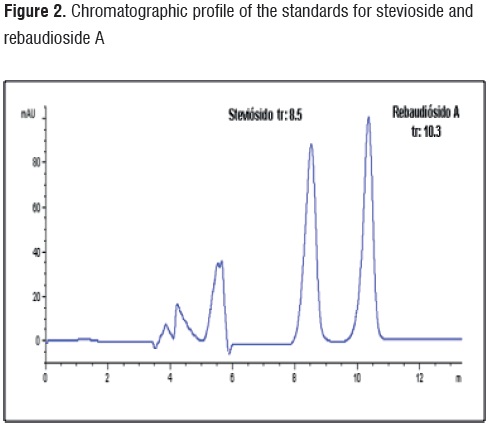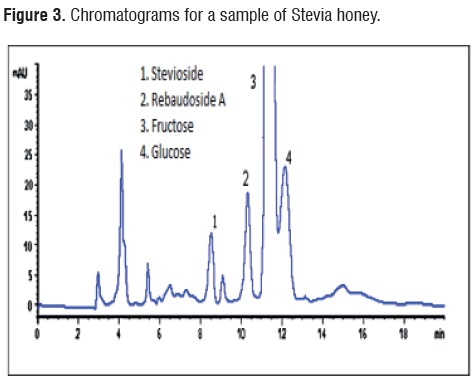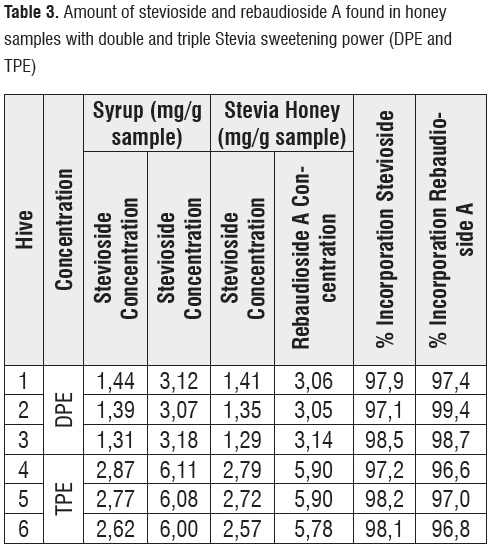Services on Demand
Journal
Article
Indicators
-
 Cited by SciELO
Cited by SciELO -
 Access statistics
Access statistics
Related links
-
 Cited by Google
Cited by Google -
 Similars in
SciELO
Similars in
SciELO -
 Similars in Google
Similars in Google
Share
Biotecnología en el Sector Agropecuario y Agroindustrial
Print version ISSN 1692-3561
Rev.Bio.Agro vol.11 no.spe Popayán Dec. 2013
DETERMINATION OF GLYCOSIDES, IN EXPRESS HONEY OF STEVIA (Stevia rebaudiana) BY LIQUID CHROMATOGRAPHY
DETERMINATION DE GLÍCOSIDOS, EN MIEL EXPRESS DE ESTEVIA (Stevia rebaudiana)POR CROMATOGRAFÍA LÍQUIDA
DETERMINAÇÃO E QUANTIFICAÇÃO DE GLICOSÍDEOS, NO MEL EXPRESSO DAS ESTÉVIA (Stevia rebaudiana) POR CROMATOGRAFIA LÍQUIDA
LUÍS ALBERTO LENIS V.1,CRISTINA RUALES C.2, RICARDO BENITEZ B.1
1Ph D. Grupo de Investigación de Química de Productos Naturales (QPN), Departamento de Química, Universidad del Cauca.
2M Sc. Grupo de Investigación de Química de Productos Naturales (QPN), Departamento de Química, Universidad del Cauca.
Correspondencia: qolenis@unicauca.edu.co
Recibido para evaluación: 26/03/2013. Aprobado para publicación: 24/07/2013.
ABSTRACT
The aim of this study was to incorporate naturally into honey the main sweet diterpene glycosides found in Stevia rebaudiana, called stevioside and rebaudioside A, in order to combine the sweetening properties of these two substances. To determine their degree of incorporation, the diterpene glycosides were identified and quantified both in the prepared syrups and in the honey obtained by the analytical technique of high performance liquid chromatography (HPLC) using a NH2 column (Zorbax-Agilent) and, as a mobile phase, a mixture of acetonitrile: water (70:30) with ultraviolet detection to 194 nm. Quantification was performed by means of a calibration curve where high rates of incorporation, exceeding 97% for stevioside and rebaudioside A, were found. For the standardization of the analytical technique, parameters were determined such as linearity, analytical sensitivity, detection limit, quantification limit and precision, showing that the method developed is simple, fast and reliable within the established limits, and levels up to 0,08 ppm for stevioside and 0,09 ppm for rebaudioside A.
KEYWORDS:Stevioside, Rebaudioside A, HPLC, Quantification.
RESUMEN
El objetivo del presente trabajo fue incorporar de forma natural en la miel los principales glicósido diterpenos dulces de la Stevia rebaudiana, denominados esteviósido y rebaudiósido A, con el fin de reunir las propiedades edulcorantes de estas dos sustancias; para comprobar su grado de incorporación se identificaron y cuantificaron los glicósido diterpenos tanto en los jarabes preparados como en la miel obtenida mediante la técnica analítica de cromatografía líquida de alta resolución (HPLC) usando una columna NH2 (Zorbax-Agilent) y como fase móvil una mezcla de acetonitrilo:agua (70:30) con detección en el rango ultravioleta a 194 nm. La cuantificación fue realizada por medio de una curva de calibración encontrándoseporcentajes de incorporación altos, superando el 97 % para esteviósido y rebaudiósido A; para la estandarización de la técnica analítica se determinaron parámetros como: linealidad, sensibilidad analítica, límite de detección, límite de cuantificación y precisión, demostrándose que el método desarrollado es simple, rápido y confiable, dentro de los límites establecidos, se detectaron niveles hasta de 0,08 ppm para steviósdio y 0,09 ppm para rebaudiósido A.
PALABRAS CLAVES: Steviósido, Rebaudiósido A, HPLC, Cuantificación.
RESUMO
O objetivo deste estudo foi o de incorporar um doce mel natural diterpenes as principais glicósido de Stevia rebaudiana, estévia e apelou rebaudiósido A, a fim de satisfazer as propriedades edulcorantes destas duas substâncias, a fim de verificar seu grau de incorporação foram identificados glicósido diterpenes quantitated e em preparações, como xaropes de mel obtidas pela técnica analítica de cromatografia líquida de alta eficiência (CLAE), utilizando uma coluna NH2 (Zorbax, Agilent) como fase móvel e uma mistura de acetonitrila: água (70:30) com detecção no ultravioleta gama em 194 nm. A quantificação foi realizada por meio de uma curva de calibração foi encontrado altas taxas de incorporação, superior a 97% para estéviosido e rebaudiosido A; para a padronização dos parâmetros analíticos foram determinados: linearidade, sensibilidade analítica, de detecção, limite identificação e precisão, mostrando que o método desenvolvido é simples, rápido e confiável dentro dos limites foram detectados níveis de até 0,08 ppm e 0,09 ppm para steviósdio para rebaudiósido A.
PALAVRAS-CHAVE: Steviósido, Rebaudiósido A, HPLC, Quantificação rápida.
INTRODUCTION
Stevia rebaudiana Bertoni, a Paraguayan herb also known as Kaa Hee or "sweet herb", has attracted a lot of interest as a potential source of natural non-caloric sweetener for use as a substitute for synthetic sweeteners. This plant is being used as a great deal in Brazil, Argentina, Paraguay, China, Korea and Japan. Stevia rebaudiana contains six diterpene glycosides with a strong sweet taste, the most abundant and important of which is stevioside, with a sweetening power 300 times greater than sucrose. Rebaubioside A is second in abundance and is 400 times sweeter than sucrose. The rest is of less commercial interest: rebaudioside C and dulcoside A and at trace level, rebaudioside E and D [1]1-3]. It has been shown that stevioside directly stimulates pancreatic B cells to considerable insulin secretion, so it is ideal for diabetics [1]4-8]. They are commonly used as natural sweeteners in beverages and foods [1]13-15], with their main properties including thermal stability up to 238°C, resistance to acid hydrolysis, they are not fermentable and, most importantly, non-toxic, making them quite attractive as additives in food and clinical applications [1]16-19]. Figure 1 presents their structures.

In this case Stevioside and Rebaudioside A are used for the preparation of syrups in the food of bees, especially in winter time or when flowering is scarce. In the Alps Apiary of the company Productos Naturales Arroyave, located in the Department of Cauca (Colombia), studies have been undertaken feeding bees with fruit juices and commercial sugar, from which honeys have been produced which are known commercially as honey express or frutimiel. There has been success with express honeys such as soybean, eucalyptus, milk, guava, passionfruit and Stevia. The main feature of this product is the combination of the properties of the honey and the juice added [1]20]. A wide range of analytical techniques have been used to identify and/or quantify the steviosides in foods, drinks and different matrices [1]21-24] which include TLC [1]26], capillary electrophoresis, enzymatic and infrared spectroscopy techniques. The most common analytical method is high pressure liquid chromatography (HPLC) [1]27-30] in which the detection is performed using the UV-Vis detector, and the separations using columns such as C18, Hidroxiapatite and amino.
The aim of this work is to obtain a honey which contains greater sweetening power than natural honey, called express honey from Stevia, besides achieving the standardization of the HPLC methodology for the identification and quantification of stevioside and rebaudioside A present in this honey.
METHOD
This research was conducted in two stages, the first in the field and the second in the laboratory.
Fieldwork
The fieldwork was carried out following the methodology described by Benítez et all. to obtain expresshoney, with selected hives.[1]31]
Selection of the hives. We worked with bees of genus Apis mellifera, using six large hives.
Preparation of the syrups.All of the required sugar was dissolved in boiling water, and then Stevia extract was added and the mixture was allowed to boil again for 5 minutes. Table 1 shows the amounts of each of the ingredients.

The dates according to the calendar to provide food for the bees are associated with periods of rain or lack of bloom throughout the year.
Express Honey Harvest. The harvest of express honey was made when there were cells of sealed honey, using the same criteria as for normal honey, following the methodology described by Benítez et all.[1]31]
Working in the laboratory
Samples were taken to the laboratory for analysis as indicated below
Chromatographic analysis. We used a high performance Hewlett-Packard 1100 Liquid chromatograph, UV-Vis detector, analytical column Agilent Zorbax NH2- 5μmx4,6x250mm, wavelength 194nm, mobile phase acetonitrile:water (70:30) in isocratic mode, with flow of 0,6 mL/min. Conditions developed in the QPN laboratory.
Stevioside and rebaudioside A ITI Miami International Inc., Florida. standards were used. The Stevia extract was purchased from Bio-Stevia SA©, Santiago de Cali-Colombia).
Sample preparation.0,020 g of Stevia honey was weighed, diluted to 10,0 mL, and passed through a nylon filter of 0,45 µm for identification by HPLC .
RESULTS
The retention times for Stevioside and rebaudioside A were determined in the HPLC column, it can be seen in the table 2. In the chromatographic profile, in figure 2, it is shown that these two glycosides can be separated with a resolution to baseline level under the experimental conditions described above.

Calibration curve
The coefficients of determination (R2) and the equation of the curve, it can be seen in the table 2, were calculated yielding R2 values very close to 1,0, indicating that the curve presents a linear behavior and is directly proportional, with a low dispersion of values.

Accuracy (Repeatability). To determine the accuracy of the method the area of two standard solutions of stevioside and rebaudioside A of 40 ppm was measured ten times consecutively and standard deviations were calculated based on the average area, in order to assess repeatability. According to the results obtained, one can observe that the values of RSD, under a parameter of confidence of 95% are low, so the method for quantification of stevioside and rebaudioside A by HPLC showed repeatability. It can be seen in the table 2.
Reproducibility. To determine the reproducibility of the method, a standard solution of 10 ppm concentration of the two glicosides was used, the measurements were carried out in triplicate for thirty days, with values less than 1,5% relative standard deviation (RSD) indicating that the chromatographic method is reproducible and reliable, it can be seen in the table 2.
Accuracy.The recovery by this method is high surpassing 99% for stevioside and rebaudioside A, thus verifying the accuracy of the system, It can be seen in the table 2.
Detection limit and quantification limit.To assess the sensitivity of the instrument and to calculate the minimum concentration detected of stevioside and rebaudioside A, two additional calibration curves are constructed in a concentration range of 1-5 mg/Kg for these glycosides. The values of both the detection limit and quantification limit are quite low indicating that the proposed methodology is sensitive and the UV detector is ideal because it has a good sensitivity to generate a minimum signal of these compounds, it can be seen in the table.
The table 3 presents the percentage of incorporation of stevioside and rebaudioside A found in honey samples with double and triple Stevia sweetening power for the six hives evaluated, an amount which exceeds 97% for stevioside and rebaudioside A. In figure 3 the chromatogram is shown for a sample of Stevia honey.

With these results, it was shown that it was possible to incorporate the main glycosides of Stevia into the honey. In order to determine whether the increased sweetness present in Stevia honey was detected by consumers, a sensory evaluation was performed.
By carrying out this study it could be determined that the bees properly assimilated the main glycosides of the Stevia, which was shown by high percentages of incorporation exceeding 97% for stevioside and rebaudioside A.

CONCLUSIONS
This research and the results obtained in it have allowed us to find a new way of producing express honey, obtaining a product with added value and features that make it attractive to the different national markets and with a high profile international. The high performance liquid chromatography (HPLC) with UV detection proved to be a good technique and a useful tool for confirmation of the existence of stevioside and rebaudioside A in samples of honey and Stevia and for quantitative determination. We managed to optimize the chromatographic parameters such as linearity in the working range, precision, accuracy and sensitivity of the method for standardization of analytical methodology that allowed the determination of the presence of stevioside and rebaudioside A in Stevia honey samples efficiently and reliably.
ACKNOWLEDGEMENTS
The authors would like to thank the Vice-Chancellor of Research at the Universidad del Cauca and the Andres Bello Agreement - Universidad del Cauca Contract # 005, for funding this research.
REFERENCES
[1]PÓL, J., HOHNOVÁ, B. and HYÖTYLÄINEN, T. Characterisation of Stevia Rebaudiana by comprehensive two-dimensional liquid chromatography time-of-flight mass spectrometry.Journal of Chromatography A., 1150 (1-2), 2007,p. 85-92. [ Links ]
[2]YODA, S.K., MARQUES, M.O.M., PETENATE, A.J. and MEIRELES, M.A. Supercritical fluid extraction from Stevia rebaudiana Bertoni using CO2 and CO2 + water: extraction kinetics and identification of extracted components. Journal of Food Engineering,57 (2), 2003, p. 125-134. [ Links ]
[3]NIKIFOROV, A.I. AND EAPEN, A.K.A 90-Day Oral (Dietary) Toxicity Study of RebaudiosideA in Sprague-Dawley Rats. International Journal of Toxicology, 27(1), 2008; p. 65-80. [ Links ]
[4]ABUDULA, R., BENDIX-JEPPESEN, P., ROLFSEN, S.E.D., XIAO, J. and HERMANSEN K. Rebaudioside A Potently Stimulates Insulin Secretion From Isolated Mouse Islets: Studies on the Dose-, Glucose-, and Calcium-Dependency. Metabolism, 53 (10),2004 p. 1378-1381. [ Links ]
[5]GREGERSEN, S., JEPPESEN, P.B., HOLST, J.J. and HERMANSEN, K. Antihyperglycemic effects of stevioside in type 2 diabetic subjects. Metabolism,53 (1), 2004, p. 73-76. [ Links ]
[6]BRUSICK, D.J. A critical review of the genetic toxicity of steviol and steviol glycosides. Food and Chemical Toxicology, 46 (7), 2008, p. S83-S91 [ Links ]
[7]ROBERTS, A. and RENWICK, A.G. Comparative toxicokinetics and metabolism of rebaudioside A, stevioside, and steviol in rats. Food and Chemical Toxicology 46 (7), 2008, p. S31-S39 [ Links ]
[8]WHEELER, A., BOILEAU, A.C., WINKLER, P.C., COMPTON, J.C., PRAKASH, I., JIANG, X. and MANDARINO, D.A. Pharmacokinetics of rebaudioside A and stevioside after single oral doses in healthy 9en. Food and Chemical Toxicology 46 (7), 2008, p. S54-S60 [ Links ]
[9]URBAN, J.D., CARAKOSTAS, M.C. and BRUSICK, D.J. Steviol glycoside safety: Is the genotoxicity database sufficient?. Food and Chem Toxicol, 51, 2013, p. 386-390. [ Links ]
[10]CARAKOSTAS, M. Letter to the editor: Long-term feeding effects of stevioside sweetener on some toxicological parameters of growing rats. Journal of Appl Toxicol, 32(2), 2012, p. 149-151. [ Links ]
[11]AWNEY, H.A., MASSOUD, M.I. EL-MAGHRABI, S., Long-term feeding effect of stevioside sweetener on some toxicological parameters of growing male rats. Journal of Appl Toxicol, 31(5), 2011, p. 431-438. [ Links ]
[12]WILLIAMS, L.D. and BURDOCK, G.A. Genotoxicity studies on a high-purity rebaudioside A preparation. Food Chem Toxicol, 47, 2009, p. 1831-1836. [ Links ]
[13]BRANDLE, J.Genetic control of rebaudioside A and C concentration in leaves of the sweet herb, Stevia rebaudiana. Can. J. Plant. Sci.,79 (1), 1999, p. 85-92. [ Links ]
[14]GEUNS, J.M.C.Stevioside. Phytochemistry,64 (5), 2003, p. 913-921. [ Links ]
[15]SCIPIONI, G.P., FERREYRA D.J., ACUÑA, M.G. AND SCHMALKO M.E. Rebaudioside A release from matrices used in a yerba maté infusion. Journal of Food Engineering 100 (4), 2010, p. 627-633 [ Links ]
[16]KUJUR, R.S., SINGH, V., RAM, M., YADAVA, H.N., SINGH, K.K., KUMARI, S. and ROY, B.K.Antidiabetic activity and phytochemical screening of crude extract of Stevia rebaudiana in alloxan induced diabetic rats. Pharmacognosy Res.,2 (4), 2010,p. 258-263. [ Links ]
[17]ADISAKWATTANA, S., JIPHIMAI, P., PRUTANOPAJAI, P., CHANATONG, B., SAPWAROBOL, S. and ARIYAPITIPAN, T.Evaluation of α-glucosidase, α-amylase and protein glycation inhibitory activities of edible plants. International Journal of. Food Science and Nutrition,61 (3), 2010, p. 295-305. [ Links ]
[18]HERRANZ-LÓPEZ, M., BARRAJÓN-CATALÁN, E., BELTRAN-DEBON, R., JOVEN, J. and MICOL, V.Stevia is a source for alternative sweeteners: Potential medicinal effects. AgroFood Ind Hi-Tech., 21 (3), 2010, p. 38-42. [ Links ]
[19]GEERAERT, B., CROMBÉ, F., HULSMANS, M., BENHABILÈS, N., GEUNS, J.M. and HOLVOET, P.Stevioside inhibits atherosclerosis by improving insulin signaling and antioxidant defense in obese insulin-resistant mice. International Journal of Obesity,34 (3), 2010, p.569-577. [ Links ]
[20]ARROYAVE, J. Manual de entrenamiento del Apicultor. 1ed. Popayán-Colombia: Apiario Los Alpes., 2002, p.15-18. [ Links ]
[21]DACOME, A.S., DASILVA, C.C., DACOSTA, C.E.M., FONTANA, J.D., ADELMANN,J. andDACOSTA, S.C. Sweet diterpenic glycosides balance of a new cultivar of Stevia rebaudiana (Bert.) Bertoni: Isolation and quantitative distribution by chromatographic, spectroscopic, and electrophoretic methods. Process. Biochemistry,40 (11), 2005, p. 3587-3594. [ Links ]
[22]HEARN, L.K. and SUBEDI, P.P. Determining levels of steviol glycosides in the leaves of Stevia rebaudiana by near infrared reflectance spectroscopy. Journalof Food Composition and Analysis,22 (2), 2009, p. 165-168. [ Links ]
[23]CHANG, S.S. and COOK, J.M. Stability studies of stevioside and rebaudioside A in carbonated beverages. Journal of Agricultural and Food Chemistry, 31 (2), 1983, p. 409-412. [ Links ]
[24]CACCIOLA, F., DELMONTE, P., JAWORSKA, K., DUGO, P., MONDELLO, L. and RADER, J.I. Employing ultra-high pressure liquid chromatography as the second dimension in a comprehensive two-dimensional system for analysis of Stevia rebaudiana extracts. Journal of Chromatography A.,1218(15), 2011, p. 2012-2018. [ Links ] [ Links ]
[26]NIKOLOVA, D., BANKOVA, B. and POPOV, S. Separation and quantitation of stevioside and rebaudioside A in plant extracts by normal-phase high performance liquid chromatography and thin-layer chromatography: A comparison.Phytochemistry Analytical,5 (2), 1994,p. 81-85. [ Links ]
[27]VANEK, T., NEPOVIM, A. and VALICEK, P. Determination of Stevioside in Plant Material and Fruit Teas. Journalof Food Composition and Analysis,14 (4), 2001,p. 383-388. [ Links ]
[28]MAMTA, P.R., VIJAYLATA, P., ARVIND, G., BIKRAM, S., RAVINDER, K.B. and RUPINDER, T.Stimulatory effect of phosphate-solubilizing bacteria on plant growth, stevioside and rebaudioside-A contents of Stevia rebaudiana Bertoni. Applied Soil Ecology,46, 2010, p. 222-229. [ Links ]
[29]YU, C., XU, K. and SHI, Y. The spectrum model established for measuring the contents of Rebaudioside A andStevioside quickly in the leaves of Stevia rebaudiana Bertoni. Energy Procedia, 5, 2011, p. 855-861. [ Links ]
[30]CATHARINO, R. and SANTOS, L.S. On-line monitoring of Stevioside sweetener hydrolysis to steviol in acidic aqueous solutions. Food Chemistry, 133(4), 2012, p. 1632-1635. [ Links ]
[31]BENÌTEZ, R., TANDIOY, A. and ASTAIZA P. Comparación del contenido de azúcares entre la miel natural y la miel express de lecha de soya (Glycine max). Biotecnologia en el sector agropecuario y agroindustrial, 3(1), 2005, p. 70-73 [ Links ]













